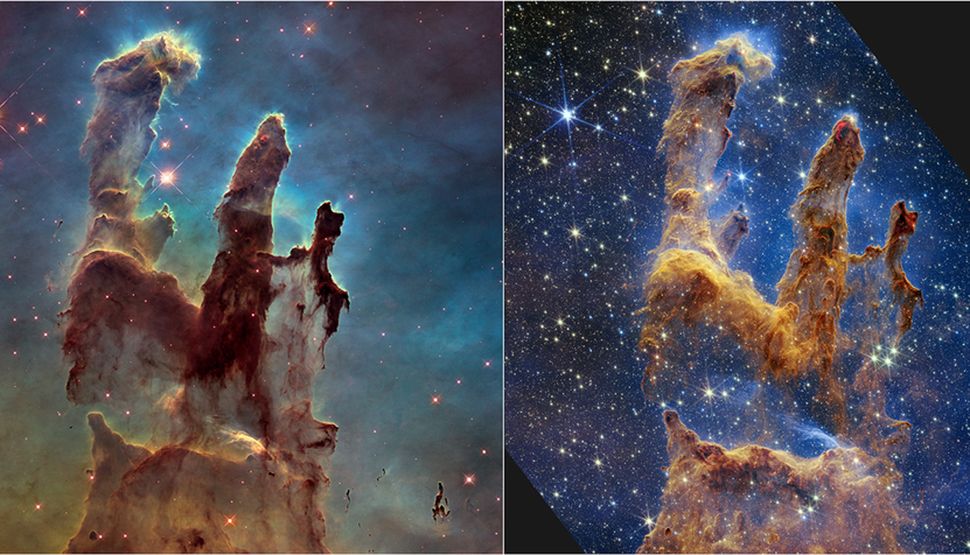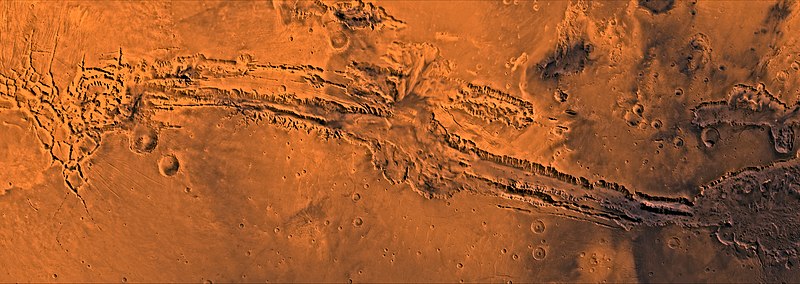Space, the final frontier, has captivated the human imagination for centuries, enticing us to look beyond our blue planet and explore the wonders of outer space. Join us on an exhilarating journey through the celestial symphony, as we unravel the mysteries of the cosmos and discover the beauty, grandeur, and significance of outer space.
The Eagle Nebula’s Pillars of Creation

The Pillars of Creation are a fascinating feature of the Eagle Nebula, a star-forming region located approximately 6,500 light-years away in the constellation Serpens. The pillars are towering structures of gas and dust that are being eroded by the intense radiation from nearby stars. These pillars are part of an active star-forming region within the nebula and hide newborn stars in their wispy columns.
The pillars are composed of molecular hydrogen and dust that are being eroded by photoevaporation from the ultraviolet light of relatively close and hot stars. The leftmost pillar is about four light-years in length, roughly the same distance as the distance from our sun to the nearest star in our milky way, alpha centauri. The finger-like projections at the top of the clouds are larger than our solar system.
These Pillars of Creation were first imaged by the Hubble Space Telescope in 1995, and since then, they have been revisited several times, including in 2014 and 2022. The 2015 near-infrared image shows the areas of star birth within the pillars in greater detail, revealing the dynamic processes of star formation. The James Webb Space Telescope took a similar near-infrared image in 2022, revealing these areas of star birth in even greater detail.
Valles Marineris

Often called the “Grand Canyon of Mars,” Valles Marineris is a massive system of canyons on the planet Mars. With a length of more than 2,500 miles (4,000 kilometers), it is the largest canyon in the solar system and is significantly deeper and longer than the Grand Canyon on Earth. This massive canyon is situated near the Martian equator, and geological processes such as tectonic activity and the stretching of the Martian crust are thought to have played a role in its formation. The intricate network of interconnecting troughs, cliffs, and canyons in Valles Marineris is remarkable, with some sections having depths of up to 7 miles (11 kilometers).
Exploring Valles Marineris provides scientists with valuable insights into Mars’ geological history and evolution, as the canyon’s features offer clues about the planet’s past tectonic and volcanic activities.
The icy geysers of Enceladus

The icy geysers of Enceladus, one of Saturn’s moons, have captivated scientists and space enthusiasts alike. Observations from the Cassini spacecraft have revealed that Enceladus is home to over 100 distinct jets of water vapor and ice particles erupting from four massive cracks near the moon’s south pole, known as the “tiger stripes”.
These geysers are believed to be powered by tidal heating, where the gravitational forces from Saturn alternately compress and stretch Enceladus, generating internal heat that melts the subsurface ice and creates a subsurface ocean. The water from this subsurface ocean simultaneously freezes and boils when it hits the cold vacuum of space, with larger particles falling back to the surface while smaller, faster ones escape to form Saturn’s faint E ring.
Analyses of the ice grains in the plumes have detected the presence of various chemical compounds, including water, carbon dioxide, methane, and even phosphorus, indicating that Enceladus has the essential ingredients to potentially support life.
The Andromeda Galaxy

The Andromeda Galaxy, also known as Messier 31 or NGC 224, is the closest major galaxy to the Milky Way, located approximately 2.5 million light-years away. It is a large, spiral galaxy similar in structure and size to our own Milky Way, with an estimated 1 trillion stars, more than the 200-400 billion stars in the Milky Way.
Andromeda is the largest member of the Local Group of galaxies, which also includes the Milky Way and about 30 other smaller galaxies. It has a diameter of around 152,000 light-years, making it one of the largest galaxies in the local universe. Andromeda is approaching the Milky Way at a speed of 100-140 km/s, and the two galaxies are expected to collide in about 4-5 billion years, potentially forming a giant elliptical or lenticular galaxy. This collision will be a significant event in the future evolution of our local galactic neighborhood.
Jupiter’s Great Red Spot

The Great Red Spot (GRS) is a massive storm on Jupiter, approximately 10,500 km in latitude and 14,750 km in longitude. It is the largest storm in the solar system and has been continuously observed for at least 150 years, possibly even longer. The GRS is an anticyclone, a long-lasting area of high pressure on Jupiter, creating a persistent storm in the planet’s Southern Hemisphere.
The storm is characterized by its red color, which is thought to be due to chemicals like ammonia in the upper part of the storm. The color can change over time, depending on whether fresh clouds are drawn into the storm. The GRS is also incredibly hot, with temperatures reaching over 2,400 degrees Fahrenheit (1,200 degrees Celsius) in the upper atmosphere. This heat is believed to be generated by the storm’s gales, which blow at speeds of up to 400 miles per hour, creating turbulence that generates sound waves and heat in the upper atmosphere.
The ice spires of Callisto

The ice spires of Callisto are a fascinating geological feature on Jupiter’s moon Callisto. These spires are approximately 80-100 meters tall and are composed of ice. They were discovered by NASA’s Galileo spacecraft in 2001 during a flyby of Callisto.
The spires are believed to have formed as a result of the sublimation of ice, where softer ice evaporates, leaving behind the harder cores. This process is thought to have occurred due to Callisto’s thin atmosphere and the moon’s low temperatures.
The spires are unique in that they are found on a moon that was previously thought to be geologically dead. Callisto’s surface is the most heavily cratered in the solar system, with no volcanoes, winds, or rain to change the landscape. The spires testify to the moon’s geological activity and the ongoing processes that shape its surface.
The next opportunity to study the spires will be in 2030 when the European Space Agency’s JUICE spacecraft will do repeated flybys of Europa and Callisto and settle into orbit around Ganymede.
Saturn’s rings

First observed by Galileo in 1610, it wasn’t until the 17th century that astronomers like Christiaan Huygens realized the true nature of these rings. Approximately 240,000 miles (386,000 km) in width, with thickness ranging from only 30 to 300 feet (9 to 90 meters). Saturn’s rings are categorized into several main groups, labeled A, B, C, and others, based on their distance from the planet. The A and B rings are the most prominent and well-defined, separated by the Cassini Division. The C ring, closer to Saturn, is fainter and less visible. These ring divisions result from gravitational interactions with Saturn’s moons, particularly the moon Mimas, which helps create gaps and clearings within the ring system.
The rings are predominantly composed of water ice, with some particles as small as grains of sand and others as large as mountains. While they create a dazzling spectacle, the rings are relatively thin, with a thickness of only a few tens of meters.
The Sombrero Galaxy

The Sombrero Galaxy, also known as Messier 104 (M104), is a fascinating spiral galaxy located approximately 28 million light-years away in the constellation Virgo. Named for its resemblance to a Mexican hat, the Sombrero Galaxy is characterized by a prominent central bulge and a large, flat disk that gives it a distinct appearance.
One of the most striking features of the Sombrero Galaxy is its bright central bulge, which is composed of older stars. Surrounding the bulge is a thick band of dust and gas, creating the hat-like structure that earned it its name. This dust lane is an active site of star formation, where new stars are born.
This Galaxy is classified as an unbarred spiral galaxy, and its spiral arms, though not as well-defined as some other spirals, extend from the central region. The galaxy’s overall appearance is a result of a tilted orientation relative to Earth, providing a unique perspective.
Conclusion
Space is a huge, amazing place with lots of cool things to discover. We’ve learned about stars, galaxies, planets, moons, and all sorts of other neat stuff. But the journey doesn’t end here! There’s still so much to explore and learn about the universe.
So, keep looking up at the night sky, and who knows? Maybe one day, you’ll be the one making amazing discoveries about space! What do you think is the coolest thing about space? Tell us in the comments!
Your Questions About Space
- What is the farthest thing we’ve seen in space? It’s a galaxy called GN-z11, which is so far away that the light we see from it started its journey when the universe was super young!
- How do scientists study space? They use big telescopes, send robots to other planets, and even study tiny bits of space dust that fall to Earth!
- Are we alone in the universe? We don’t know yet, but scientists are looking for signs of life on other planets and moons. It would be so cool to find out we’re not alone!
- What are the biggest mysteries of space? There are so many mysteries! Some of the biggest ones are what makes up most of the universe (we call it “dark matter” and “dark energy”), how the universe started, and if there’s life out there.
